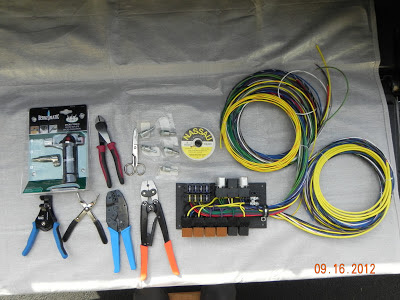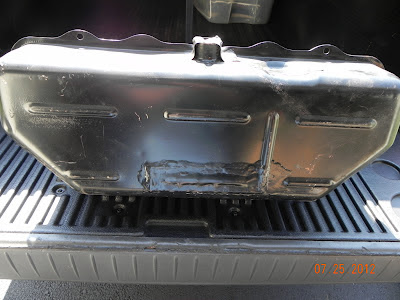Since Tillie is going through a complete ground up restoration, new brake lines and all related brake components have been either rebuilt or replaced. Same with the clutch, all new or rebuilt. So, I've put all those components together and now comes the moment of truth...adding the brake fluid and seeing what leaks !
I had heard enough horror stories on the 6-Pack forum about paint damage caused by DOT 3 or 4 brake fluid, so the decision to use the more expensive DOT 5 was a no brainer. Dot 5 is silicone based and will not eat your fancy paint job for lunch, where as DOT 3 & 4 are glycol based and will damage that expensive paint job. One of the big problems of switching over to DOT 5 is that it is not compatible with DOT 3 or 4, but in my case, everything was new and dry, so no old fluids to worry about.
I'd like to say that all my connections were solid with no leaks, but that's not the way it happened...I wiped up more brake fluid than I care to admit, but hey, there are a lot of pipe joints....
The PDWA switch is used to alert the driver if one of the two brake circuits goes bad. This simple device has just two rubber "O" rings that can leak, and yep, mine leaked. I had used the wrong size "O" rings. :-(
Front Brake Flex Lines
Front Brake Calipers
Rear Brake Wheel Cylinder
Rear brake flex lines..well, you get the idea....lots of joints that have to be perfect, and they are...now. ;-)
The hydraulic brake and clutch can't have any air in the lines in order to function properly, so getting that air out (once the leaks are fixed) is very important.
Growing up, my job was always the "pumper" when it came time to bleed the brake lines after replacing the brake shoes on the family's '58 Ford. I'd sit in the car and my dad would be at the wheel opening. He would use an end wrench and a tube ( connected to the wheel cylinder bleeder) that went into a jar used to catch the brake fluid. He'd say, "push the brake pedal and hold it." Dad would then open the bleeder, watch for the air bubbles / fluid to come out, then close the bleeder and tell me to repeat the push and hold process. Once just fluid and no air came out of that particular wheel cylinder, he'd move on to the next wheel after adding more fluid to the master cylinder. This method still works, but I figured there had to be an easier, one- person way to accomplish this task, so I did what any 21st century person would do...I did a Google search on bleeding brakes!
I found lots of options, but Phoenix Systems makes a one- person bleeder that can do a reverse bleed process. It pulls the fluid out of the container at the wheel and pushes it up to the master cylinder. This seemed to work pretty good once the leaks were fixed, but even the directions that come with it say that you may need to pump fluid from the master cylinder back to the wheel cylinder to get rid of all the air, and I still had air in the lines.

After several hours of "messing" around trying to get all the air out, I took a break and did what I should have done in the beginning ....I did a search on the 6-Pack forum regarding bleeding brakes. When I came across the term "Speed Bleeder", learned how it works, (a small ball bearing and spring that keep out unwanted air), I got on eBay and ordered a set for all four wheels and one for the clutch slave cylinder.
The eBay vendor is located here in Ohio, so I had my new bleeders in two days. The idea behind these little jewels is that one person can crack open the bleeder then pump the brake pedal (without needing a second person). The ball bearing and spring close off the bleeder when you release the brake pedal. Now ideally, a second person could watch the fluid as it comes out of the bleeder and tell you when no more air bubbles appear, I just kept pumping until no bubbles were in the drain line and catch bottle.
I was finally getting close, but the brake pedal still went almost to the floor before getting solid, and I knew something was still not right. More 6-Pack forum searches produced my answer....I needed to adjust the rear brakes up solid, then back the adjuster off one quarter turn. Bingo, the brake pedal felt perfect.
The clutch on a TR6 is hydraulic with a master cylinder and a slave cylinder. Once I got the solid pipe and flexible braided line installed, the speed bleeder made easy work of getting rid of the air.
Master Cylinder

Slave cylinder with drain tube attached to the bleeder.
Oh, there was just one little problem. It looks like there is plenty of fluid in the clutch master cylinder, but that amount is only good for about 4 pushes on the clutch pedal....try for a 5th push and you will hear a sucking sound. ARRGH, I just sucked air back into the line. Start over and be more careful !
I'm quite confident my brakes and clutch are road worthy, but on this type of restoration it will be months before I can do a road test, so I'm going to move on to the radiator...stay tuned !


















































